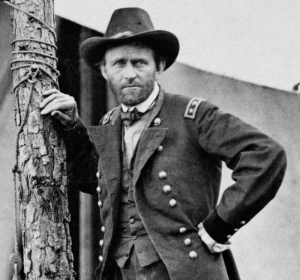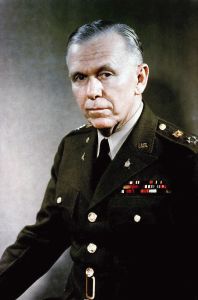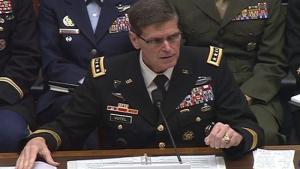Why does the U.S. military invest so much pride in working to the point of tedium, if not exhaustion? A friend of mine, an Army major, worked at the Pentagon. He worked hard during his normal shift, after which he did what sensible people do – he went home. His co-workers, noses to the grindstone, would hassle him about leaving “early.” He’d reply, I can leave on-time because I don’t waste hours at the coffee maker or in the gym.
A caffeinated emphasis on work and fitness, another friend suggested, may be a post-Vietnam War reaction to Secretary of Defense Robert McNamara’s “managerial culture” of the 1960s. As he put it, “One easy way of showing one has the ‘right stuff’ [in the US military] is to be an exercise nut, and the penumbras of that mindset have really distorted the allocation of effort in our military.”
Two recent examples of work- and fitness-mania are Army Generals David Petraeus and Stanley McChrystal. The US media extolled them as ascetic-warriors, yet both flamed out due to serious errors in judgment (Petraeus for an affair with his biographer, with whom he illegally shared highly classified information, and McChrystal for tolerating a climate that undermined his civilian chain of command). Asceticism and sweaty fitness routines, after all, are no substitute for sound judgment and a disciplined mind.
Busy-work within the military is related to Parkinson’s Law, the idea that work expands to fill the time allotted to it. In this case, with America’s wars on terror being open-ended, or “multi-generational” as the US military puts it, the “work” on these wars will continue to expand to fill this time, with the added benefit of “validating” the extra money ($54 billion in 2017 alone) being shoveled to the Pentagon by President Trump.
Along with busy-work are the virtues of suffering, as related by a societal celebration of Navy SEALs and similar special forces (“100 men will test today/but only three win the Green Beret”). I’ve lost count of the times I’ve read articles and seen films featuring these “supermen” and their arduous training. The meme of “sweet–and public–suffering” is related to the whole “warrior” ideal (more on this later) within the US military. There’s a self-righteous shininess here, a triumph of image over substance, or image as substance. (Being physically tough is of course an asset in close quarters combat, but it’s no guarantor of strategic sense or even of common sense.)
In the past, some of America’s finest military leaders had no shame in appearing common, most famously the “shabby” Ulysses S. Grant during the US Civil War.

Civil War officers – true citizen-soldiers, most of them – often had unruly hair and unkempt beards, but they sure as hell fought hard and got the job done. Nowadays, as another reader put it, “there appears to be a whole lot of Army officers who think a white sidewall haircut proves you’re a great officer. It actually is a homage to the Prussian Army that shaved its soldiers’ heads to prevent lice.”
Speaking again of image, let’s take a close look at the beribboned uniforms of today’s military officers. General Joseph Votel, presently US Centcom commander, is only the most recent example of an excess of ribbons, badges, and other devices:
Contrast Votel’s image to that of General George C. Marshall, who defeated Nazi Germany and Imperial Japan during World War II.

How did Marshall manage such military feats with so few ribbons? Nowadays, US generals sport more bling than the Kardashians.
But let’s return to the notion of US troops as “warriors” and “warfighters.” I’ve written extensively on this subject. I see today’s “warrior” conceit as a way of eliminating our democratic citizen-soldier ideal, making the US military a thoroughly professional force, subservient to the government and divorced from the people.
However, there’s another aspect to this “warrior” mythology, a powerful psychological one: the duping of the “warriors” themselves, distracting them from a bitter reality they may be little more than cannon fodder for greed-war.* The US military today is awash with warrior creeds that to me are antithetical to the citizen-soldier ideal of America.
To sum up the US military’s current ethos, then: We have a lot of guys who take great pride in constant busy-work and excessive physical exertion, sporting high and tight haircuts, their uniforms festooned with bewildering displays of ribbons and medals and badges, extolling a warrior code in the service of a government that tells them that multi-generational wars are unavoidable.
And so it shall prove, if these shadows remain unaltered.
*Thanks to Michael Murry for bringing my attention to how the semiotics of “warrior” are dramatically changed if we substitute “gladiator” for “warrior,” followed by less grandiose terms such as “those about to die,” i.e. as scapegoats to the king’s ambition, an insight he gleaned from reading Umberto Eco.
William J. Astore is a retired lieutenant colonel (USAF). He taught history for fifteen years at military and civilian schools and blogs at Bracing Views. He can be reached at wastore@pct.edu. Reprinted from Bracing Views with the author’s permission.





Yes!!! Wow the military is so filled with fainting twerps at the General and Flag level! Glad I’m retired.
A soldier will fight long and hard for a bit of colored ribbon.” – Napoleon Bonaparte
Read “About Face” for a good real treatment of warfare, then try on “War is a Racket” written by the most decorated warrior in America, EVER!
I saw a picture of a young person in uniform with about 12 ribbons on the uniform. I investigated, they were 3rd year in the ROTC.
Still in college.
Utter madness.
Did my Para training 50+ years ago. No Non-com shouted at us. No violence of any kind. We could leave at any point and return to unit. If we wanted to be or stay a Para, we just had to keep up. (out of about 3,000 original volunteers, 67 got their wings.)
It was called Leadership.
When the officers deigned to appear, they made the Non-coms look like Nancys.
First time out with company commander (Captain) we had a 60 mile stroll. We had had 3 months of running and marching whilst he sat behind a comfortable desk. After about 20 miles we stopped for a break, the Captain took off his boot and poured blood out of it. Removed his sock and poured Methylated Spirits over his foot.
Put his sock and boot back on, laced up and said “Right are you lot ready?” and off we went.
There seems to have been a lot of “decoration inflation” over the decades. My recollection (I’d have to look it up on my DD-214, which is buried somewhere in a bunch of other papers) is that after 10 years and one war in the US Marine Corps, I had 13 medals and ribbons. None of them were for things like individual valor. Unit commendations, pro forma decorations like the National Defense, Good Conduct and Sea Service Deployment medals/ribbons, multiple iterations of the same award, etc. Looked nice and flashy on the dress uniform, but didn’t mean much in terms of what I had actually done.
Cadet Alison Childress of West Brunswick High School sported an impressive array of medals as she
https://uploads.disquscdn.com/images/0269281e43b6ddff33626e6c82991b31cb3acb17388a2a3e939817c5e9582872.jpg
You obviously weren’t really trying.
Helmuth von Moltke didn’t have tits,
He also failed to go to the right high school.
The other interesting thing is that he spent 10 years as a second lieutenant.
During his ten years, he obtained a 3 year degree in military science, attended the staff college, was seconded to Denmark, and a bunch of other stuff. I get the feeling that one would only be promoted when you had command of men.
What I love about cadet Childress is the girl scout badges on her other chest, 3 tip Double French Braid aiguillette, not even 3rd Regiment French Foreign Legion with all their history achieved that.
Still apparently the green means that she is a Marine, so …..
Was there any value in the metal, as in silver, gold, lead, iron content?
“,,,and the penumbras of that mindset have really distorted the allocation of effort in our military.”
Of the 4 definitions offered in Miriam-Webster’s only the 4th appears to give us a clue as to what this meaningless sentence might mean:
4.: something that covers, surrounds, or obscures : shroud a penumbra of secrecy
In other words, “…and the [covering of obscurity] of that mindset have distorted….”
Only the Latin roots give us a clue: from Latin paene almost + umbra shadow. Almost a shadow.
But an unspoken, hidden mindset of mindless activity and physical fitness regimens is actually a shadow mindset. Not a penumbra, which mostly refers to astronomical events.
Why is your friend using a 50 dollar word when a 50 cent word [i.e., shadows] would be the correct word to describe what he’s trying to say? What person would use the word penumbra in a casual conversation? Sounds like you made up the word to sound more intelligent. You, the writer.
Is your entire article a penumbra?
Next time, back off the intellectual high-fallutin’ theatrics. You don’t need them at all to make your points.